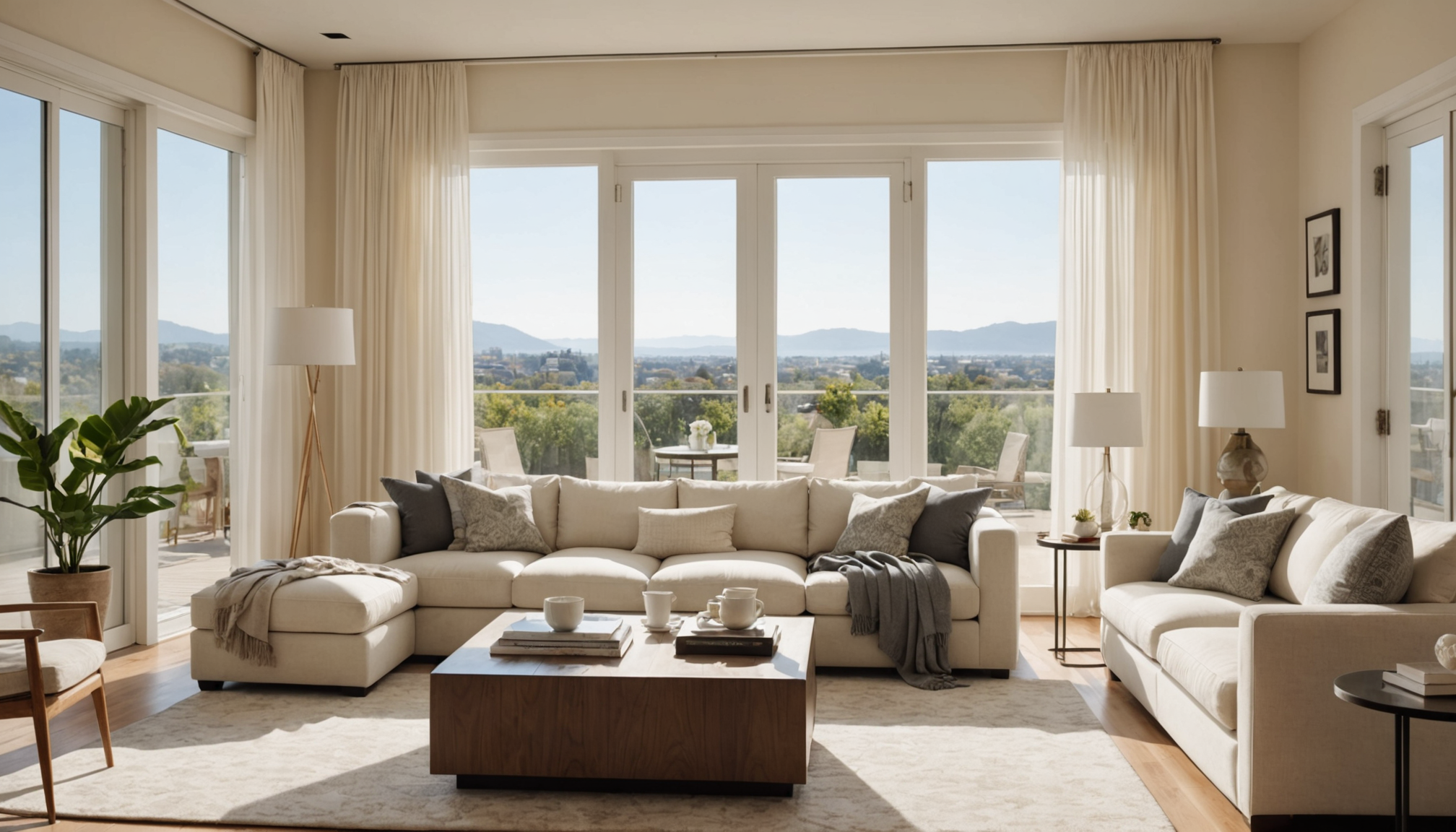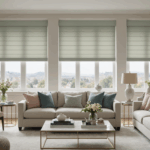Maximizing natural light is a fundamental design principle that can significantly enhance the ambiance of small spaces, making them feel larger, airier, and more welcoming. Natural light has the unique ability to transform a confined area by bringing in depth and movement that artificial lighting often lacks. Implementing strategies to enhance natural light involves a harmonious balance of window placement, window treatments, and interior layouts.
One of the most effective strategies is to keep window areas unobstructed. Heavy curtains or large pieces of furniture directly in front of windows can block sunlight, so consider using lighter window treatments such as sheer or light linen curtains, which allow sunlight to filter through and brighten the room while maintaining privacy. Blinds can be adjusted throughout the day to control the lighting levels without compromising the influx of natural light.
Strategic furnishing is also key—placing reflective items such as glass or metallic furniture near windows can help bounce light around the room. Similarly, walls and ceilings painted in light colors, such as whites, creams, or pastels, reflect more light than darker colors, contributing to an open and airy feel. Consider a matte or eggshell finish for walls, which will still reflect light but also offer a modern, sophisticated texture. This approach is especially beneficial for spaces with limited windows, as it maximizes the available light.
In addition, if your space layout allows, create an open-plan living area that channels natural light flow throughout without barriers. Removing or minimizing the number of unessential interior doors ensures that light can move freely between rooms. Where possible, consider widening or adding new windows, perhaps opting for floor-to-ceiling models that offer an expansive view and plentiful daylight.
For those interested in enhancing the effects of natural light in a space, it may be useful to compare various types of window treatments and their efficacy in facilitating light. Below is a comparison that highlights some common options:
| Window Treatment | Light Filtering | Privacy | Recommended Space |
| Sheer Curtains | High | Low to Moderate | Living rooms and kitchens |
| Solar Shades | Moderate | High | Home offices, kitchens |
| Venetian Blinds | Adjustable | High | Bedrooms, home offices |
| Light Linen Curtains | Moderate | Moderate | Bedrooms, dining rooms |
By thoughtfully considering these elements and how they interact with your small space, you can make the most of natural light, transforming the atmosphere and functionality of your home while enhancing its aesthetic appeal. It’s not just about increasing brightness—it’s about creating an environment that feels open and connected to the outside world.
Choosing multifunctional furniture
Furniture that serves multiple purposes can be a game-changer when decorating small spaces. By selecting pieces thoughtfully, you can maximize utility without overwhelming the area, all while maintaining a stylish and cohesive look. Here’s how you can effectively choose multifunctional furniture:
- Assess Your Space and Needs:
- Begin by carefully evaluating how you use your space. Consider the activities you need to accommodate—be it working, eating, or entertaining.
- Make a list of furniture essentials and see if some pieces can fulfill more than one of these purposes.
- Consider Convertible Furniture:
- Sofas that convert into beds or tables that transform from coffee tables to dining tables can save significant space and cater to varied functions.
- Look for furniture designed with seamless mechanics and aesthetics that complement your overall decor.
- Integrate Storage Solutions:
- Choose furniture that offers hidden storage, such as ottomans, beds with drawers, or side tables with shelves.
- This allows you to keep clutter out of sight while maintaining easy access to your belongings.
- Opt for Modular and Stackable Designs:
- Modular furniture pieces can be reconfigured as needed, providing flexibility in how space is used over time.
- Stackable chairs and tables offer practical solutions for hosting more guests without requiring permanent additional space.
- Embrace Lightweight and Portable Pieces:
- Furniture that’s easy to move around allows you to adapt your layout for different occasions or needs.
- Consider pieces with wheels, foldable options, or items made from lightweight materials for greater maneuverability.
- Focus on Unifying Aesthetics:
- While functionality is key, maintaining a cohesive look through complementary colors, materials, and styles helps avoid visual clutter.
- Ensure the multifunctional pieces align with the overall theme of your space to create a harmonious environment.
By incorporating these strategies, you can select furniture that not only fulfills multiple roles but also enhances the visual and functional appeal of your small space. Remember, the key is to prioritize flexibility, utility, and aesthetics to craft a living area that’s both practical and inviting.
Utilizing vertical space
When it comes to effectively decorating small spaces, adopting a strategy that emphasizes height instead of floor space can lead to remarkable transformations. Thinking vertically involves leveraging every inch of your space above ground level to its fullest potential. This approach not only makes the most of the available square footage but also creates a sense of grandeur and openness even in the coziest of rooms.
Wall-mounted shelving is one of the most practical ways to utilize vertical space. By installing shelves up to the ceiling, you create abundant storage and display opportunities without taking up floor space. This can be particularly beneficial in rooms that lack sufficient storage options. Use these shelves to display books, plants, decorative items, or storage bins to keep essentials organized while adding character to your room.
Vertical cabinets and bookcases further enhance storage capacity. Choose pieces that are tall and narrow to maximize height usage without encroaching on valuable floor space. This method is especially effective in kitchens, where vertical pantry units can house culinary essentials and keep countertops clutter-free, or in home offices, where tall bookcases can neatly store documents and office supplies.
Incorporating hooks and pegboards provides another layer of vertical storage useful in areas like kitchens, entryways, and bathrooms. Install hooks on the back of doors or on walls to hang coats, bags, or towels. Pegboards can be used to hang kitchen utensils or tools, offering a customizable and flexible organizational system that can be easily adapted to fit your changing needs.
Use of ladders or step stools opens up the potential of higher surfaces in your space. Consider decorative ladders to drape blankets in living areas or use a library ladder for accessing higher shelves effortlessly. This not only maximizes the use of vertical space but also adds a stylish element to your decor.
Opt for tall furniture pieces like high-backed sofas or elongated headboards in the bedroom which draw the eye upwards, giving an illusion of a more spacious environment. These furniture pieces act as visual anchors, introducing a vertical element that adds depth to the room’s overall aesthetic.
Moreover, vertical gardening offers an innovative solution for incorporating greenery without occupying floor space. Whether through hanging planters, wall-mounted garden beds, or stacked plant towers, bringing nature indoors can enhance the visual appeal and ambiance of your space, promoting a serene and inviting atmosphere.
By focusing on the verticality of your room, you can transform it beyond its perceived limitations. This approach not only optimizes space but also invites creativity, enabling you to design an environment that is both functional and visually appealing. Such strategies highlight the incredible potential that lies above, waiting to be discovered in every small space.
Incorporating mirrors strategically
Incorporating mirrors in your design can significantly enhance the feeling of openness and spaciousness in small areas. By reflecting both natural and artificial light, mirrors brighten a room and create the illusion of depth and scale, making spaces seem larger than they actually are. Strategic placement of these reflective surfaces can dramatically transform the energy and appearance of your compact living area.
Position mirrors opposite windows or beside light sources to amplify illumination and give the impression of additional windows. This technique not only maximizes light but also visually extends a room. Consider using larger mirrors or a series of smaller ones to increase the reflective surface area—these can be framed in materials that complement the rest of your decor, maintaining aesthetic consistency.
For a bold statement, an oversized mirror with an ornate frame can serve as a focal point, drawing the eye and adding elegance. Such a feature piece not only breaks up solid walls but also interacts beautifully with surrounding elements, providing balance and intrigue. In narrow spaces, such as hallways or small entryways, vertical mirrors elongate the view and help in dispersing light along the corridor.
A mirrored furniture piece, such as a coffee table or console, introduces simultaneous functionality and reflective qualities. These pieces subtly integrate mirrors into your decor scheme without overwhelming the space. Mirrored surfaces can double as storage while fostering a sense of airiness, critical in dense settings such as urban apartments or compact homes.
Mirrors can also be used to reflect elements you’d like to highlight, like artwork or a striking chandelier. This intentional reflection not only enhances the item itself but also becomes an integral part of the room’s overall design. For rooms with limited or no windows, consider incorporating mirrored panels across a portion of the wall. This creates the illusion of a connection to the outdoors, tricking the eye into perceiving a larger expanse.
Think about using mirrors creatively—a collage of geometrically shaped mirrors can serve as functional wall art, providing dimension and personality. Similarly, mirrored backsplashes in kitchens or bathrooms reflect light and space, adding a touch of sophistication while maintaining practicality.
Ultimately, the strategic placement of mirrors can be a cost-effective way to transform the perception and comfort of small spaces. Harness the power of reflection to enhance both functionality and style, achieving an atmosphere where space feels open, light, and imbued with energy. Remember, the goal is to create environments that feel expansive and inviting, using mirrors as a tool to seamlessly blend beauty with spatial efficiency.
Opting for a cohesive color palette
A cohesive color palette in small spaces is essential for creating a sense of unity and making the area appear more extensive and less cluttered. By thoughtfully selecting harmonious colors and tones, you can achieve a visually soothing environment that feels intentional and stylish while enhancing the overall spatial perception.
Start by choosing a base color that complements the natural light available in the space. Lighter shades such as soft whites, pale greys, or muted pastels can reflect light and help open up the room. These shades create a neutral backdrop that makes the space feel larger and provides the perfect canvas for further color layering.
Introduce additional colors through accent pieces like cushions, rugs, or artwork. These accents should be in a similar tone to the base color but can offer slightly more depth to add interest without overwhelming. Consider incorporating a mix of textures and finishes in the same color family to add depth and interest—think matte, gloss, or metallic finishes that catch the light differently.
Keeping key pieces like furniture and large installations in neutral and understated shades not only keeps the space feeling cohesive but also allows you to easily update your decor with new accent colors as seasons or trends change. Limit bold colors to accessories or smaller decor items; this will prevent the room from feeling chaotic while still allowing for personality and character to shine through.
To tie various elements into the overall color scheme, consider using a single, unifying shade across trims, moldings, or frames—this can effectively create a layer of cohesion that holds the aesthetic together seamlessly. By consistently applying similar tones, even subtle details become part of the overall design narrative.
Finally, ensure that your choices in color enhance the design features you want to highlight, such as a beautiful window or architectural detail. Thoughtful use of color can emphasize structural elegance, guide the eye, and distinguish zones in an open-plan concept without physical divisions.
In summary, designing small spaces with intentional decorator choices like maximizing natural light, opting for multifunctional furniture, utilizing vertical expanses, and incorporating mirrors become exponentially powerful when coupled with a cohesive color palette. By applying these strategies, you create a dynamic and personalized space that reflects a sophisticated balance of style and practicality, transforming even the tiniest nook into a place of comfort and inspiration.


